C O N T E N T S
•
•
Photo Corners headlinesarchivemikepasini.com
![]()
A S C R A P B O O K O F S O L U T I O N S F O R T H E P H O T O G R A P H E R
![]()
Enhancing the enjoyment of taking pictures with news that matters, features that entertain and images that delight. Published frequently.
Test Drive: Peak Design Everyday Messenger Bag 13




15 September 2016
When Peak Design branched out from camera straps to camera bags, it launched a 15-inch messenger bag designed for what it called "everyday" use. That means you aren't required to pack it with a camera.
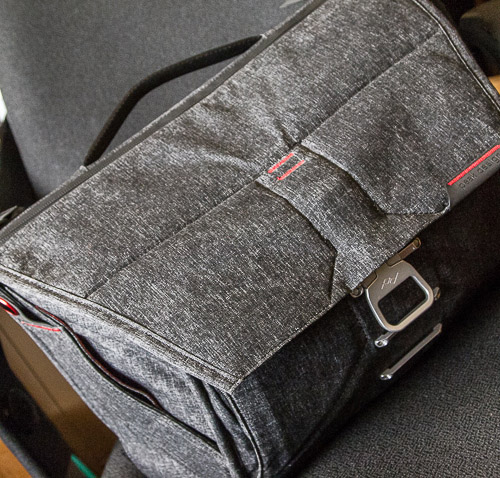
Everyday Messenger Bag 13. Packed to the gills (but you can hardly tell).
And, indeed, that's the thing about messenger bags. They're big old floppy things that hold nearly anything and ride on your back. Dave Crockett style. Yeehaw.
It's a simple concept but it's a tough sell. The 15-incher was a little too large for most tastes and, when fully packed, too heavy to carry. Besides, who doesn't have a 13-inch laptop to haul everywhere they go?
So the smaller 13-inch design was born.
But like it's older sibling, there are two things that stand out about it:
- It's extremely well made.
- It's extremely well thought out.
So it took us a little while to get acquainted with it. A few months, in fact.
DESIGN SCORES
There's a lot to like about the Everyday Messenger Bag 13. Here are our favorite features:

The FlexFold dividers will make or break your main compartment packing success. They're unusual, folding in ways you may not expect (read on for a trick), like origami, but nicely illustrated in the included documentation.
They're a bit stiffer than the gear dividers you may be used to (but those would work here too, Velcro being Velcro). A newer design we saw when the company launched their backpacks, is double-walled and can be folded in two dimensions, providing two levels of storage.

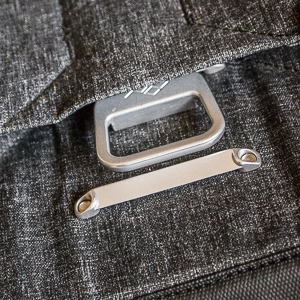
The MagLatch is an ingenious design. The latch itself is magnetic and snaps to the ladder of rungs before it slips upward to grab onto the nearest hook. Which hook that is depends on how much stuff you've put in the bag. To open it, you just pull the latch down a bit to release it from the hook.
This works even if your load is unevenly distributed in the bag, unlike the venerable lock latch that only closes when you press the latch down evenly into its slot.

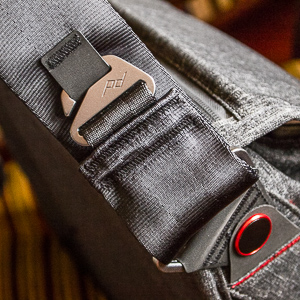

Quick Adjuster. Closed.
The shoulder strap looks conventional (a good thing for looping it over your shoulder or across your back) but it's anchored to the bag by swiveling rivets instead of being sown in awkwardly. Very comfortable. And those rivets are covered by fabric on the inside of the bag to protect your valuables.
It also features the Quick Adjuster that Peak Design made famous on its camera straps. Lift the metal bar and change the length of the strap. Then close the bar to lock it out of the way.
A smaller stabilizer strap is hidden in each of the side pockets. One of them can be attached to the shoulder strap under your arm pit so the bag won't slide around on your back. Or you can attach them to each other to form a belt to secure heavier loads.
There's also a tethered strap with an Anchor Link on it for your keys, say.

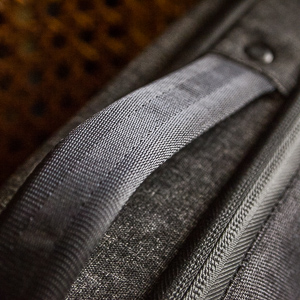
The handle is soft and flexible. It's also riveted to the bag so it it will stick around a while.
If it were just a little wider, we could have slipped a telescoping roller handle through it.

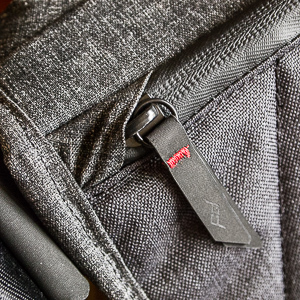
There are some little design features that impressed us as well:
- Zipper covers. In the closed position, the zippers are covered by the water-resistant fabric. You just slide the zipper right in and you won't snag them or expose them to rain.
- Zipper fabric. What good would a zipper be in weather-resistant fabric if its own fabric was porous? Don't worry, the zipper fabric on this bag is rubberized.
- Zipper pulls. The rubberized pulls are sown shut with red thread so they're easy to find. And unlike other pulls (which always seem too large), they sit discretely on the bag until you need them.
- Unique hardware. Peak Design designs its own hardware fixtures like latches and hooks. Rather than pay 10 cents for off-the-shelf parts, they pay 60 cents for custom hardware. And it makes all the difference in function.
As a messenger bag, we expected a big floppy old envelopish thing. But the Everyday Messenger Bag 13 is stiff. It holds its shape when collapsed because the sides are thick and the back panel's multiple layers don't give. We found that helpful for large loads and not a problem on small ones, even if a bit less efficient.
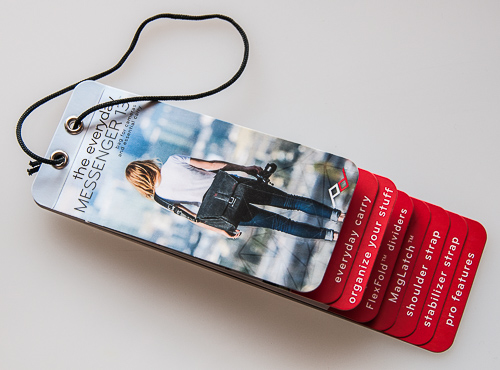
Documentation. Seven illustrated spreads tells you everything
DESIGN 'MISSES'
We tried to come up with some legitimate design misses, but we could only come up with a few pseudo misses. Most of these have a nice workaround.
Conspicuously missing from the Messenger 13 is any kind of rain cover. When we asked Peak Design about that, they told us it doesn't need one. The material itself is water resistant. Nice answer. But this omission might matter to you anyway.
Not many of us are messengers cruising the asphalt on an old big balloon tired bike. Our messenger bags are more likely to make the daily commute with us and accompany us on airplanes as we save the world one way or another. So we really did miss a pass-through for the handle of rolling luggage.
You can't easily wrap the shoulder strap around a telescoping luggage handle either because it's pretty stiff itself.
When we brought this to Peak Design's attention, they pointed out that they recommend three ways to lash the bag to a roller:
- Take both ends of the stabilizer strap out of their stow pockets and hook them together.
- Weave the stabilizer straps through the Messenger Bag handle and the telescoping handle.
- Tighten the shoulder strap and loop it over the handle, letting the bag sit behind your roller.
Of the three, we find the second the most secure:

We hinted above that we might prefer the newer double-walled dividers, but Design told us even these dividers can be sued for two-level stacking:

And while the shallow but stretchable little pockets in the accessories section can hold a pen or lens brush, there isn't a barrel pocket for them. That would have been a nice, familiar touch.
While not actually a miss, the tripod carrier didn't work for our smaller, travel tripod. The tripod legs can only attach at the center column to slide all the way across the bag. Our travel tripod has a brace (or two connections on the leg) that prevent it from slipping into the channel on the bag flap.
Oh, one more thing we missed: an accessible, dedicated pocket for a smartphone. OK, your phone is usually in your hand and when it's not, it's in your pocket. But we'd still like to see a smartphone pocket for it in the bag that lets us easily retrieve our phone.
Peak Design's helpful info card suggests putting your phone in the shallow pocket on the inside wall of the main compartment. And that would work because you can unzip the top of the bag to get into that compartment. But it's a little too awkward to call accessible.
We found we could slip our iPhone 6 Plus into the side pocket but we felt it was a little insecure there.
You can chalk up these "misses," such as they are, to the messenger bag genre itself. And if they matter to you, you might consider something more like Peak Design's new backpacks.
USAGE
A messenger bag, of course, won't work as a backpack. And it won't work as a day pack either. It's more in the luggage line, carrying a lot of stuff conveniently from one place to another. But it really isn't designed to let you work out of it in between stops.
We could fit a dSLR with a zoom lens on it into the main compartment but when everything else was packed in, it wasn't a very efficient fit. The interior is just not quite wide enough. The solution would be to remove the lens. A Micro Four Thirds camera swam in the space, though.
So we would pack the Messenger 13 for either a daily commute or travel. While it isn't the right bag for a hike, it could work on the street in a pinch with a small camera.
And in a pinch, you can mount a camera to the shoulder strap itself with the company's Capture camera clip which fits straps up to three inches wide with a quick release holder for an Arca-compatible quick release.

Laptop. A tight fit.
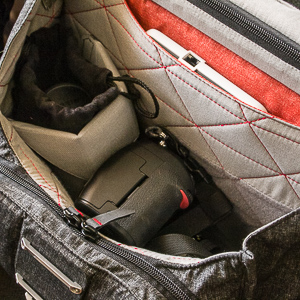
Lens, Camera. Room for more.
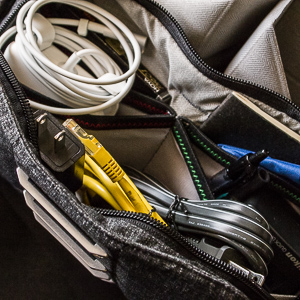
Accessories. Crammed full.
TRIP PACKING
We keep a packing list for travel, so we collected everything on the list to see if the Messenger 13 could handle it all.
Here's the full list with commute-only items in italics:
- 13-inch MacBook Pro
- MacBook Pro power adapter
- Kingston MobileLite WiFi router
- Kingston power adapter
- Ethernet cable
- USB cable
- Nikon D300
- 35mm f2.8 Nikkor
- 18-200mm Nikkor
- Nikon battery charger
- Nikon charger power cord
- Microfiber cleaning cloth
- Lens pen
- Polarizer in case
- Three thumbdrives
- Spare memory cards
- Notepad
- Pen
That's the full list of what we were able to pack easily into the bag. We might have include a case for our glasses as well. Total weight: 11.4 lbs.
With the computer and accessories installed first, the camera compartment was a little tight. It had nowhere to expand. But it was still easy to get the lens and camera in there.
There isn't a lot of play in the computer slot. Even with the zipper wide open, it's a tight fit, at least with our laptop. You want to keep the case as flat as possible to make the opening as wide as it will go. Same goes for getting the computer out.
But note that this was a 2011 MacBook Pro with a DVD drive, so it was a bit thicker than current models.
COMMUTE PACKING
For the commute to our downtown office (well, the Mechanics' Library), we pack much differently.
We still want to bring the MacBook Pro along with its charger but we don't need the battery charger for the camera or the storage drives. We also don't need a router or its adapter. And we could lose a few cables (Ethernet, USB), too.
That keeps the bag's profile commute friendly, which is quite different from airport friendly. We wouldn't wear it over our shoulder but carry it by the handle so we wouldn't knock people over in the aisles of the streetcar.
A VISIT
Peak Design has offices in San Francisco where we visited recently with founder Pete Dering (he wanted a company name with his own initials, he joked) and several employees, including designer Art Liger who pointed out some of the finer details in the bags.
The office itself reflects the company's passion for invention. It has unusually tall ceilings that have been employed as a parking lot for the employees who commute by bike (which several do). There's a pulley system that hoists the bikes to the ceiling, out of the way of everyone on the floor.
There is a full kitchen and a bank of computers, facilitating discussion, which is something they do all day, Dering said. In a corner there's a small shop to fabricate various concepts and in between there's a small stage for shooting product images.
So where do the bags get made?
Peter Lockett, the supply chain director, told us the company is working with a Vietnamese manufacturer and represents 60 percent of their production. Vietnam has much better Internet access than China, Lockett said, and are leading the way in luggage manufacturing.
Peak Design visits the factory three weeks a year, which is about three times normal. The usual order is 15,000 bags but Peak Design orders 35,000.
Dering's company is, he proudly pointed out, not beholden to venture capitalists but driven by its customers via Kickstarter. When Peak Designs kicks around a new idea, they propose it to their customers on Kickstarter and generate the funding to put it into production.
The company also announced earlier this year it had joined 1% For The Planet, a non-profit organization that connects over 1,200 member companies with initiatives to support a healthy planet.
PRICE, AVAILABILITY
At $219.95 the Messenger 13 is not an inexpensive bag but the price reflects its value, something we don't often get to say.
Peak Design told us they would expect the bags to last about 10 years in normal use. But they offer a lifetime warranty, digital marketing director Elish Patel explained. Should anything go wrong, they'd replace the bag because, frankly, they have no repair facilities.
CONCLUSION
We've tested a handful of messenger bags over the years. There always seems to be some fatal flaw. So we rely on a smaller bag like a Domke for our camera gear and a briefcase bag for our computer. But a two-bag scheme doesn't fly these days.
Both a messenger bag and a backpack can consolidate your gear.
Backpacks can carry a lot and the extra weight is evenly distributed across both shoulders. But they can be bulky and awkward (try turning around in an airplane or bus aisle with one on your back).
A messenger bag is not a backpack. It's more like a large briefcase with a catch-all compartment and a sidecar. Some can fit a laptop, some can't. Some are large enough for a dSLR and accessories, some aren't.
We found the Everyday Messenger 13 to be large enough to hold a laptop and dSLR combination without being too bulky and heavy for carrying cross-shoulder. That qualifies it for airline travel in our book.
We also found it small enough for everyday commuting. Even though it's a stiff bag, it carries a small load compactly. And it's so light, you can sling it or carry it.
It's also a pleasure to use. The thought that went into the design from the concept to the smallest details is more what you'd expect from an artisan making a tool for their own use than a product that can be made inexpensively and sold for a healthy profit.
It could be improved with a pass-through loop but it's a pretty impressive design achievement as it is. And that gets it a four photo corner rating from us.